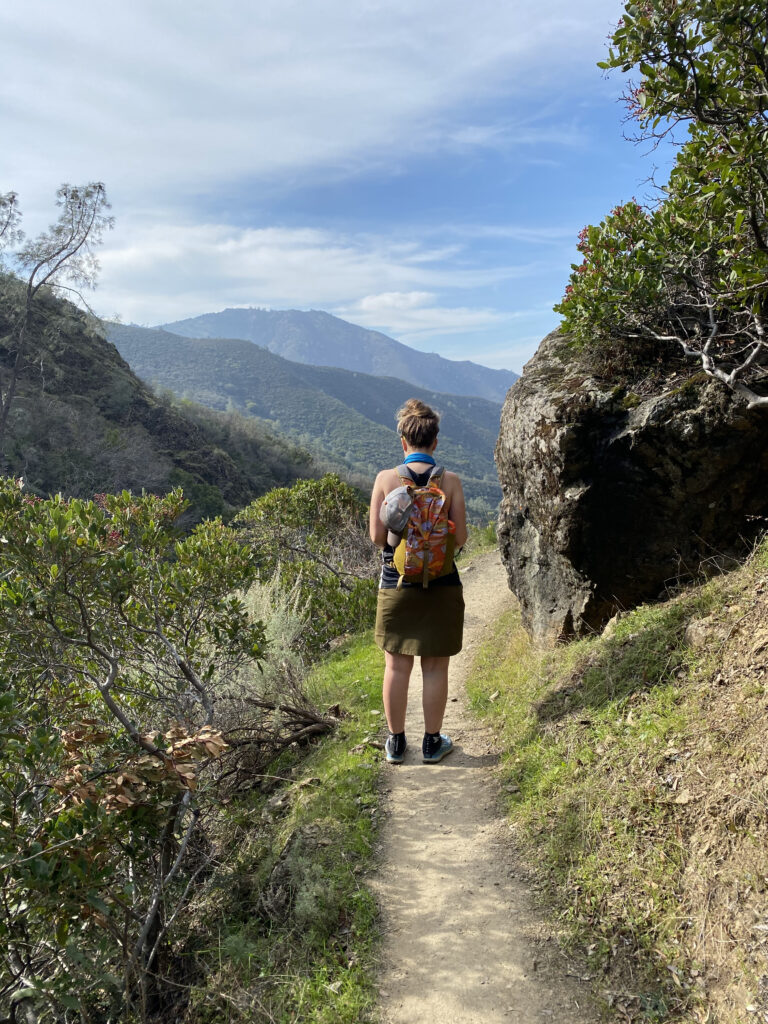When introverts go exploring
What To Bring on a Day Hike: The 10 Essentials
Posted on April 25, 2023 by Joanna Redmond


Whether you’re new to hiking, or a seasoned veteran, there are ten essentials that anyone will need on a hike. Even if you plan to be gone for just a few hours, be it a day hike or a more extended backpacking trip, these ten essentials will help you prepare for the unexpected.
As we like to say, hiking is an endurance challenge mixed with problem-solving. Or, in other words, expect the unexpected. Because if you spend any amount of time in the wilderness, something unexpected will happen that may cause you to be caught off guard. That being said, if you are prepared, you can handle anything that nature throws your way.
Navigation
Maps and hiking or outdoorsy apps are great options. If you don’t know how to read a map, especially a topographical map, learn. It’s best to rely on something other than your phone, which can break, die, or end up lost while exploring.
If you rely on an app, download the map before you leave so you can access it even if you don’t have service. One app I love to use is All Trails. Check back soon for an article all about this hiking app.
Light Source (preferably a headlamp)
Headlamps are the best option because they’re lightweight and leave your hands free to do other things, like tend the fire and set up the tent. Also, should you find yourself out after dark, a headlamp will free up your hands to use hiking poles instead.
Sun Protection
There are many reasons to avoid overexposure to the sun. Sunburn, heatstroke, and skin cancer are among them. Consider wearing a hat with a brim. Wear sunscreen, and remember your sunglasses. Also, research sun shirts. They’re lightweight and effective at UV protection.
Also, I like to wear or pack sun gloves. They barely weigh a thing and double as a blister guard on my hands from my trekking poles.

First Aid and Blister Care
The unfortunate truth about hiking is that you’ll get a blister at one time or another. While I’ve avoided most blisters by investing in blister resist socks and wearing the right shoes, I may still get the nasty buggers if I hike long enough. For blister care, I like to carry a blister kit. When I feel a hot spot, I stop walking and put on a blister pad. Staying ahead of the worst of it helps blisters and hot spots to heal faster so you can keep on truckin’.
Knife and Repair Kit
Okay, most day hikes won’t require bringing a complete repair kit. However, I use repair kits on overnight and longer backpacking trips. They’re great to have if your tent or puffy needs repairing. However, I almost always have some sort of knife with me, even while trail running. Knives are extremely handy and can even help save your life if it comes to that.
Fire Starter
Packing a way to start a fire, even for a day hike, is just about the same as a knife. You won’t need it until you need it, and then you’ll probably really need it. Some reasons you may need a firestarter on a day hike will be:
Extra Food
Good choices for extra food include anything that is high-calorie and lightweight.
Even if you’re not hungry, you need to eat. Food needs to be treated more like medicine when hiking and backpacking. Not eating can be detrimental to both your hike and your health. Pack something you know you’ll want to eat. Your tastes and cravings can change, so pack a few different choices. For example, I’ll pack two flavors of vegan jerky, some trail mix, a piece of fruit, and two different types of bars.
Extra Water
Water is life. Without water, it would be tough to make miles or survive should the unthinkable happen.
Another way to make sure you stay hydrated is to pack a lightweight water filter. Even the pen filters can save your life, especially if you know you’ll be near a water source.
Extra Clothing
Weather can be unpredictable. Weather predictions are only sometimes accurate. Rain, thunder, and high winds can all come out of nowhere. Bing layers. Consider a lightweight jacket (like a windbreaker) that folds up to the size of its pocket. You may also want to pack a raincoat, warm gloves, and a hat. Whatever you choose, avoid cotton and instead choose moisture-wicking materials.
Shelter
No, you don’t have to pack a tent for a day hike. Something as simple as a windbreaker and an emergency blanket will do the trick. I pack a blanket I got after some of my races. You can shove these things into just about any pocket or pouch and add only a negligible amount of weight.
Bring the Essentials, Don’t Overpack
While carrying the ten essentials may seem like a lot, nothing on this list is considered frivolous – or what we call a luxury item. Also, most of these things don’t weigh much, and some of them, such as sun protection, are worn weight – meaning you wear the item, you don’t pack it in your backpack.
Category: backpacking, Hiking
Recent Posts
Archives
Categories
Copyright © 2025 · All Rights Reserved · IntrovertOutdoors
Theme: Natural Lite by Organic Themes · RSS Feed · Log in
Recent Comments